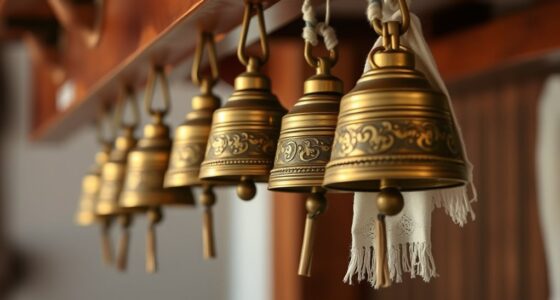Bike mirrors come in three popular styles: bar-end, helmet-mounted, and eyewear options. Bar-end mirrors attach at handlebar ends, giving you a broad rear view and stable perspective, perfect for road riding. Helmet mirrors offer quick, hands-free awareness, ideal for mountain biking and urban commutes. Eyewear mirrors are discreet and integrated into your glasses for subtle visibility. Understanding these styles helps you choose the best for your riding environment—more details await as you continue.
Key Takeaways
- Bar-end mirrors attach at handlebar ends, offering wide rear views ideal for road cycling.
- Helmet mirrors mount directly on helmets for quick, hands-free awareness during urban or mountain biking.
- Eyewear-style mirrors are integrated into glasses or goggles, providing discreet, low-profile rear visibility.
- Mounting options include handlebar, stem, or adhesive bases, ensuring stability and easy adjustment.
- Material durability and weather resistance are essential for long-lasting, reliable bike mirror performance.

Bike mirrors are vital safety accessories that help you stay aware of your surroundings while riding. With a variety of mounting options available, you can choose the setup that best fits your bike and riding style. Some mirrors mount directly onto the handlebars, often using threaded or clamp-style mounts, offering a secure fit that’s easy to adjust. Others use innovative mounting options like stem mounts or adhesive bases, giving you flexibility if your bike’s design limits traditional handlebar attachments. When selecting a mirror, consider how easy it is to install and adjust, since a stable, well-mounted mirror guarantees you get a clear view without constantly readjusting it during your ride.
Mirror shapes also play an indispensable role in your overall safety and comfort. Round mirrors tend to be classic and unobtrusive, providing a wide field of view with minimal distraction. Rectangular or square shapes often offer a larger viewing area, making it easier to see approaching vehicles and cyclists behind you. Some mirrors have an oval shape, balancing a broad field of view with a sleek profile. The shape you choose should complement your riding position and visual preferences, ensuring that you can quickly glance at your mirror without losing focus on the road ahead.
Mirror shapes enhance safety and comfort by providing wide, unobtrusive views tailored to your riding style and preferences.
Bar-end mirrors are a popular choice for many riders, especially those who prefer a minimal, aerodynamic look. They attach at the ends of your handlebars and typically feature a sturdy arm that extends outward, giving you a wide, clear view of what’s behind. Helmet mirrors, on the other hand, are mounted directly onto your helmet, allowing you to check your surroundings without changing your hand position or reaching for your handlebar-mounted mirror. They’re especially handy for quick glances during fast-paced rides or technical trails, where every second counts. Eyewear-style mirrors are integrated into glasses or goggles, offering a discreet way to stay aware without adding much bulk. These are perfect for commuters who want seamless visibility without extra accessories.
Each style has its advantages depending on your riding environment and personal comfort. Bar-end mirrors are great for road cycling, providing stability and a broad view. Helmet mirrors are ideal for mountain biking or urban riding, where quick situational awareness is indispensable. Eyewear mirrors blend into your gear, offering a subtle solution that doesn’t interfere with your vision or comfort. Proper mounting options and mirror shapes are key to maximizing your safety, helping you maintain awareness and confidence on every ride. Additionally, selecting appropriate materials for your mirrors can enhance durability and weather resistance, ensuring longevity in various riding conditions.
Frequently Asked Questions
Are Bike Mirrors Legal in All Countries?
You should know that bike mirrors aren’t legal everywhere, as international regulations vary. Some countries require mirror certification to guarantee safety standards are met, while others have no specific rules. It’s important to check your local laws before installing mirrors on your bike. By doing so, you avoid fines or penalties, and you make sure you’re riding safely and within the law, wherever you are.
How Do I Adjust Mirror Angle for Best Visibility?
Imagine your mirror catching the morning sun as you ride; that’s when you know you’ve achieved the perfect view. To adjust the mirror angle for best visibility, sit comfortably on your bike and gently tilt or rotate the mirror until you can see clearly behind you without straining. Make small adjustments, ensuring the mirror frame aligns with your peripheral vision, so you get ideal visibility and stay safe on the road.
Do Bike Mirrors Affect Helmet Safety?
Bike mirrors generally don’t affect helmet safety if you choose durable mirrors and wear your helmet properly. Well-designed mirrors with impact-resistant materials won’t compromise your helmet’s ability to protect you during a crash. However, cheap or fragile mirrors could cause injury if they break during an accident. Always pick high-quality, durable mirrors and guarantee your helmet is properly fitted to maintain maximum safety and minimize helmet impact risks.
Can I Install Multiple Mirror Types on One Bike?
Yes, you can install multiple mirror types on your bike. To do so, consider the mirror mounting options and verify they don’t interfere with each other or your riding. Check mirror size considerations to prevent clutter or restricted visibility. Using different mounting styles—like bar-end, helmet, or eyewear mirrors—can give you better awareness without compromising safety or comfort. Just make sure they’re securely attached and don’t hinder your movement.
What Maintenance Is Required for Bike Mirrors?
To keep your bike mirrors in good shape, regularly clean the mirror surface with a soft cloth and mild soap to maintain clear visibility. Check the hinges and moving parts, and apply some hinge lubrication if they feel stiff or squeaky. This simple maintenance guarantees your mirrors stay secure, functional, and easy to adjust, enhancing your safety while riding. Regular upkeep prevents damage and keeps your mirrors looking and working like new.
Conclusion
With the right bike mirror, you’ll navigate your ride like a hawk soaring through the sky—sharp, aware, and confident. Whether you choose bar-end, helmet, or eyewear styles, each offers a unique window to the world behind you. Embrace your choice, and let your vision be as clear as a crystal lake. Ride with safety and style, turning every journey into a smooth, scenic voyage where you’re always in control of your adventure.









